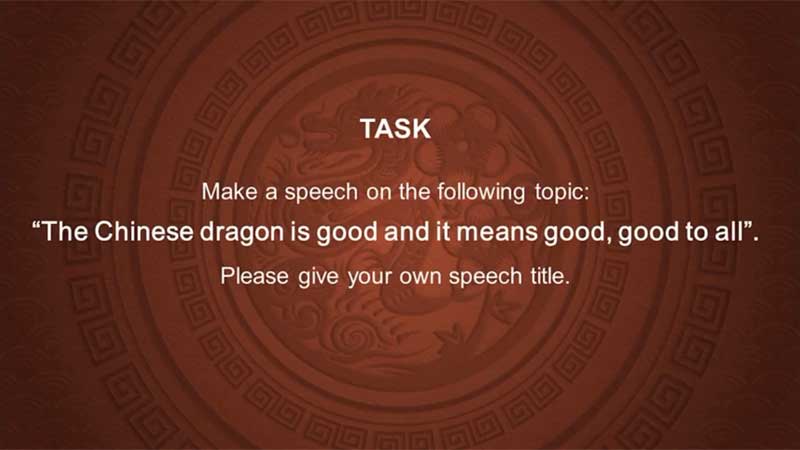首页 为什么是“龙的传人”? 信箱:1131376436@qq.com T: 13671606831 《译龙风云》 |
|
辅导材料,南辕北辙:为参赛同学的成绩担忧 —— 大赛题目是歌颂 Chinese dragon,辅导老师却译龙为 loong 原标题:周一,国家形象.中国龙竟然不是“龙”? |

本期推文,我们特别推出了关于中国龙形象的专题推送,旨在为同学们备战外研社演讲大赛(涵盖校赛、省赛、国赛)提供灵感与素材。本次大赛的定题演讲题目为“The Chinese Dragon is Good”,愿此推送能激发同学们的思考与创意,帮助你们在演讲中以龙的精神为引领,展现中华文化的魅力与风采。祝同学们备赛过程充实而愉快,最终在赛场上以精彩的表现赢得荣誉与掌声! No one knows exactly when the legend of the loong first originated, but the symbol dates back to at least 3000 BC. According to one theory, the legendary loong evolved from the ancient practice of totem worship. The image of the loong is a kind of artistic creation based on the primitive thinking of people in the primitive period. Today, it is commonly depicted as a combination of nine animal characteristics -- the horns of a deer, the head of a camel, the eyes of a rabbit, the neck of a snake, the belly of a clam, the scales of a fish, the claws of an eagle, the paws of a tiger and the ears of an ox -- as recorded in a book on flora and fauna written in the Song (960-1279) and Yuan (1271-1368) dynasties. 没有人确切知道关于龙的传说最早起源于什么时候,但这个符号至少可以追溯到公元前 3000 年。根据一种理论,传说中的中国龙是从古老的图腾崇拜实践演变而来的。龙的形象是原始时期人们在原始思维基础上的一种艺术创造。今天,它通常被描述为九种动物特征的组合——鹿角、骆驼头、兔子眼睛、蛇脖子、蛤蜊腹部、鱼鳞、鹰爪、虎爪和牛耳——正如宋代(960-1279)和元代(1271-1368)的一本动植物志中所记载的那样。 ……。 (黄佶编辑配图,2024年10月15日) 相关链接: 专题:外研社外语演讲大赛:Chinese dragon is good |
(返回顶部) 返回首页 《译龙风云——文化负载词的翻译:争议及研究》全文免费下载 |